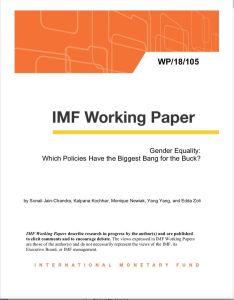
Sonali Jain-Chandra, Kalpana Kochhar, Monique Newiak, Yang Yang and Edda Zoli
Gender Equality
Which Policies Have the Biggest Bang for the Buck?
IMF, 2018
What's inside?
Gender inequality is an accepted fact in many nations, but smart public policy can shrink it.
Recommendation
The critical yet elusive response to the question of how to reduce gender inequality in the labor market has dogged policy makers for decades. This enlightening study from a team of IMF researchers relies on rigorous analytical approaches to determine the most significant factors associated with gender inequality. Their findings point to some promising ideas and potential solutions that may surprise you. getAbstract recommends this study to executives, policy experts and analysts for its insights into gender issues.
Take-Aways
- Despite some advances toward gender equality, women remain marginalized and disadvantaged in a number of major areas, including education, labor force participation, pay, and access to legal and social services.
- A 2018 study of 100 countries from 1980 to 2014 identified the factors that most strongly affect female representation in the labor market.
- Access to electricity, water and sanitation allows women to get jobs. Higher educational attainment can boost female employment by as much as one-third.
- Policies likely to promote gender equality include tax credits for low-income workers; the removal of legal barriers to inheritance and property ownership; and government spending on infrastructure, education, health care and childcare.
- Stronger job protection measures are helpful only up to a point, after which they can actually increase gender inequality.
Summary
Despite some advances toward gender equality, women remain marginalized and disadvantaged in a number of major areas, including education, labor force participation, pay, and access to legal and social services. These disparities, which are particularly acute in emerging and low-income economies, take a toll on economic development.
“Vast empirical evidence exists to show that significant macroeconomic gains can be realized when women are able to develop their full labor market potential.”
A 2018 study of 100 countries from 1980 to 2014 identified the factors that most strongly affect female representation in the labor market. For example, high fertility levels and wide age differences between spouses correlate with large workforce gender gaps. Domestic activities, such as child-rearing and the “home-based production of goods and services,” adversely influence women’s ability to work outside the home. Access to electricity, water and sanitation allows more women to get jobs. Higher educational attainment can boost female employment by as much as one-third.
“Better infrastructure, a stronger institutional environment, more equal legal rights and low adolescent fertility rates are strongly associated with higher female labor force participation.”
The gender gap narrows and widens based on a nation’s economic development. Subsistence economies typically boast large numbers of working women, because both men and women need to work to survive. But as a country’s per capita GDP increases, labor force gender disparities increase as well, as women trade paying jobs for family duties. Then, at even higher income levels, the gap contracts again, as affordable childcare and household services become available.
“Labor market protection appears to have a nonlinear relationship [with] labor market participation gaps.”
Policy initiatives likely to promote gender equality include tax credits or incentives for low-income workers; the removal of legal barriers to inheritance and property ownership; and government spending on infrastructure, education, health care and childcare. Enacting job protection measures in economies that lack strong labor safeguards can motivate women to join the workforce.
But, surprisingly, these laws are helpful only up to a certain point, after which they can actually increase gender inequality. For example, the study shows that female participation declines in response to a mandated “larger maximum number of working days” per week. Research indicates that too rigidly regulated job markets can exacerbate rather than reduce gender inequality at work.
About the Authors
Sonali Jain-Chandra et al. are professionals at the International Monetary Fund.
This document is restricted to personal use only.
My Highlights
Did you like this summary?
Get the ReportThis summary has been shared with you by getAbstract.
We find, rate and summarize relevant knowledge to help people make better decisions in business and in their private lives.
Already a customer? Log in here.



















Comment on this summary